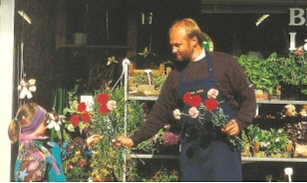|
Startseite
© 2015, 2016 Dr. Graumann-Brunt |
|||
© Dr.Sigrid Graumann-Brunt Der trianguläre (=referentielle) Blickkontakt, was ist das? Beteiligt sind am triangulären Blickkontakt zwei Personen und ein Objekt des gemeinsamen Interesses (tri=3). Das Kind beginnt irgendwann (natürlicherweise) den Partner anzusehen und ihn mit seinem Blick auf einen Gegenstand zu verweisen. Die beiden Personen verständigen sich per Blickkontakt über eine Sachlage, einen Gegenstand, eine Wahrnehmung oder Ähnliches. Diese Art der Verständigung ist zunächst nonverbal, später sagt das Kind auch so etwas wie „dada“ über einen Ball oder „brumm, brumm“ über ein Auto (siehe hierzu die Literatur von Zollinger). 
Denken und Rechnen 1 Nord 1998 Seite 19 Westermann Verlag Braunschweig Kann der trianguläre Blickkontakt fehlen? Ja, er kann fehlen, bei autistischen Kindern scheint er auszubleiben. Die Kommunikation bleibt ohne den Blickkontakt rudimentär oder entwickelt sich gar nicht. Ist es schwierig, den triangulären Blickkontakt das erste Mal herzustellen, wenn er sich nicht von selbst einstellt? Ja, es ist für das Kind nicht ganz einfach, denn erstens braucht das Fokussieren sehr viel Energie, weiter ist ein Beitrag des Gleichgewichts für das Halten des Blickkontakts erforderlich, überdies muss die Integration der beiden „Augenbilder“ geleistet werden (auf zentraler Ebene) und es muss ein gewisses Vertrauen da sein, um dem anderen direkt in die Augen zu blicken. Ein sehr junger Säugling schafft das alles noch nicht, auch die dafür erforderlichen Kopfwendungen sind ihm in einem gezielten Ablauf noch nicht möglich. An Asymmetrien im Schädelbereich, die sich auf die Position der Augen auswirken, sollte notfalls craniosakral gearbeitet werden (Keilbeinflügel!). Kann man den triangulären Blickkontakt trainieren? Ja, das ist möglich und das sollte man auf jeden Fall versuchen, wenn der Blickkontakt nicht gut ist. Es braucht jedoch am Anfang sehr viel Geduld und Konzentration, da man den umherschweifenden Blick des Kindes „fangen“ und dann einen Augenblick lang „festhalten“ muss. Welche Hilfsmittel gibt es, den triangulären Blickkontakt anzubahnen? Man kann mit dem ausgestreckten Zeigefinger deuten, sich zueinander wenden und sich anschauen und sich verständigen, etwa über ein Auto oder ein Tier, oder, wie auf dem Bild oben, über Blumen. Ein weiteres Hilfsmittel, das sich bewährt hat, ist ein Ball, den man sich mit einem Kind zuwirft. Man folgt dessen Bewegung instinktiv mit den Augen. Bälle, die nicht springen, sind dafür geeigneter (z.B. Koosh—Bälle). Die Aufforderung, den Ball zu werfen, wird das Kind zu Beginn mit den Augen geben. Auch hier bedarf es des Fingerspitzengefühls, denn einerseits soll der Blickkontakt provoziert werden, andererseits darf nicht zu lange gewartet werden, da das Kind sonst die Lust verliert. Besser ist es übrigens, wenn bei diesem Spiel beide Personen auf dem Boden sitzen (man muss nicht ständig aufstehen, um die Bälle zu holen). Mehr im Heft 8. Das Kinderspiel und Aspekte der neurophysiologischen Entwicklung, siehe auch Zollinger. Den Text zum Thema Blickkontakt und Beginn der Verständigung als pdf-Dokument und zum Drucken finden Sie hier: Klicken Sie dazu in das Quadrat: The eye contact triangle (=referential eye contact): What is it? It requires two people and an object of mutual interest (tri=3). At some point the child (quite naturally) begins to look at its partner and to draw their attention visually to an object. Both persons communicate with one another regarding a given situation, an object, something perceived or such like by means of eye contact. At first this form of communication is non-verbal; later on the child will also say something such as „dada“ referring to a ball or „brumm, brumm“ to refer to a car (see the writings of Zollinger). 
Denken und Rechnen 1 Nord 1998 Seite 19 Westermann Verlag Braunschweig May the referential eye contact never happen? Yes, it may never happen. It seems not to occur with autistic children. Without eye contact communication remains rudimentary or does not develop at all. Is it difficult to establish the initial referential eye contact if it doesn´t occur naturally? Yes, it is not quite so easy for the child because the act of focussing requires very much energy and balance also has a part to play in maintaining eye contact. Furthermore, the child needs to trust in order to look the other person straight in the eye. A very young baby is not yet in a position to do so as it is not yet able, to turn its head in any controlled manner to focus. Where asymmetry (in the region) of the skull may be affecting the position of the eyes, craniosacral treatment should be applied if necessary. Can referential eye contact be trained? The answer is yes, it is possible and should definitely be tried if visual contact is not good enough. However, this will require a lot of patience and concentration at first because one has to „catch“ the child´s roaming eyes and then „hold“ them for a brief moment. What tools can be used to encourage referential eye contact? One can point with the outstretched index finger, turn to face and look at one another and to communicate by referring to a car or an animal, or, as shown in the picture above, to flowers. Another tool that has proved useful is a ball that can be shown to and fro between adult and child. The eyes instinctively follow the movement of the ball. Balls, that do not bounce are better suited to this purpose (eg. Koosh balls). To begin with the child will use its eyes to give the other person a visual cue to throw the ball. Again this exercise must be done with a degree of intuition and sensitivity because while allowing a brief moment to induce eye contact, one mustn´t wait too long because the child will lose interest. It is better, one must add, for this exercise when both persons are seated on the floor (to avoid having to continually get up to fetch the ball). Mehr im Heft 8. Das Kinderspiel und Aspekte der neurophysiologischen Entwicklung, siehe auch Zollinger. For the text on the eye contact and early communication as a pdf file or print-out click here on the square. |

